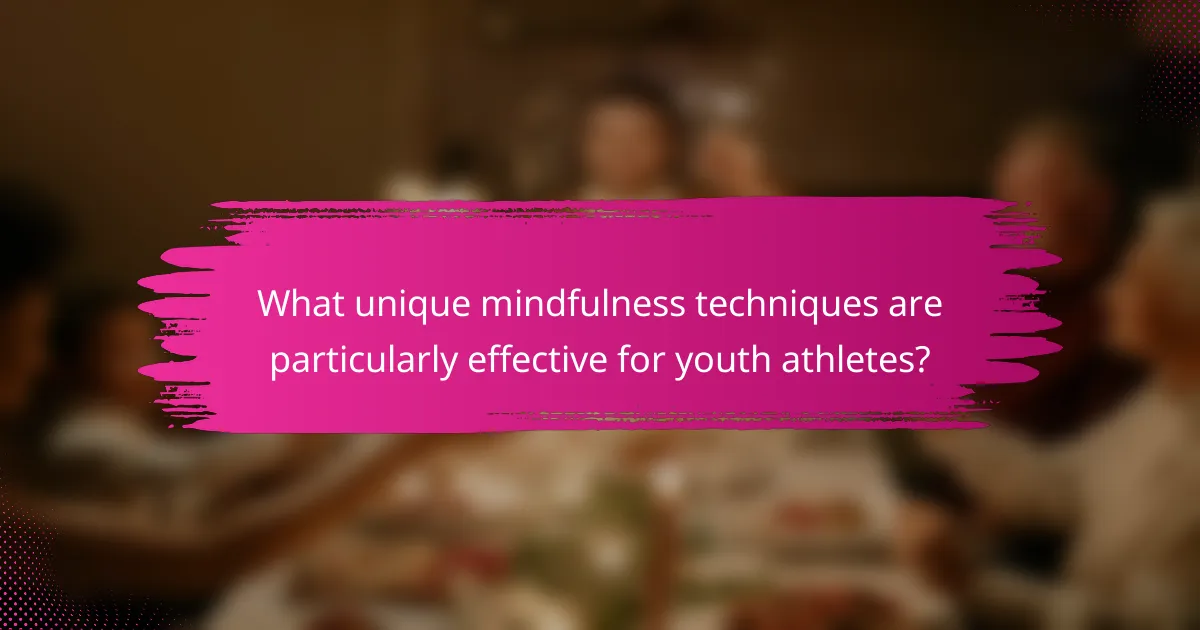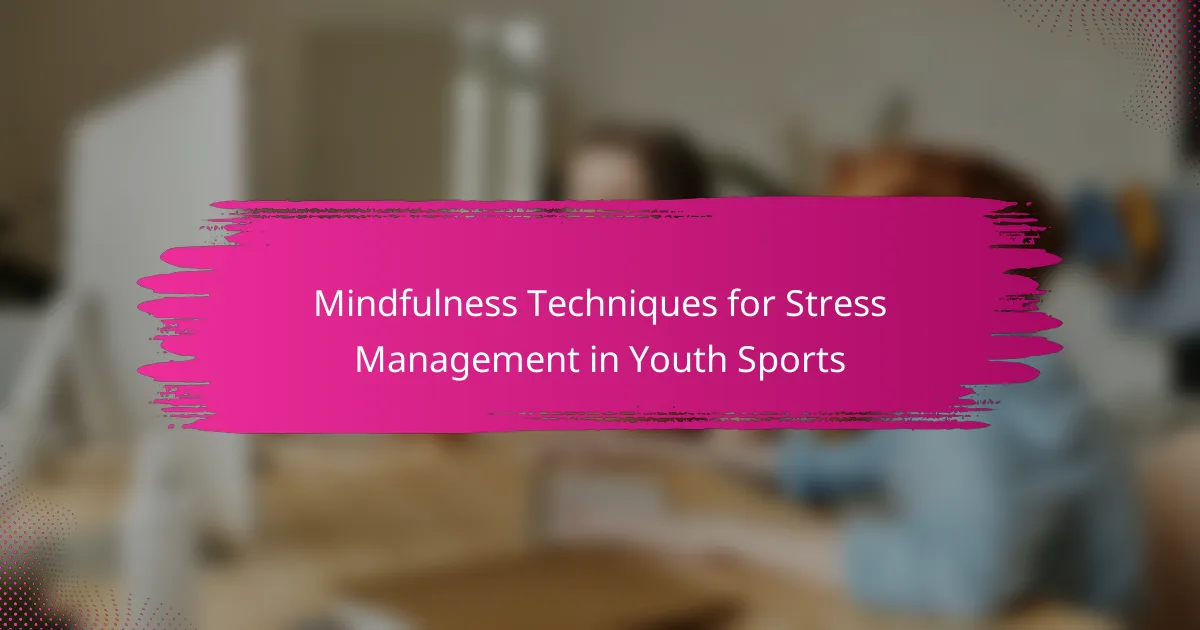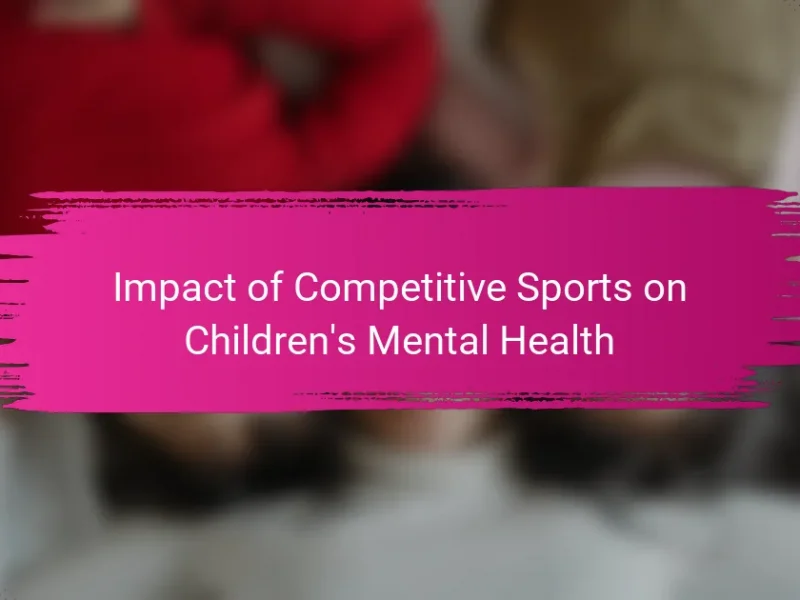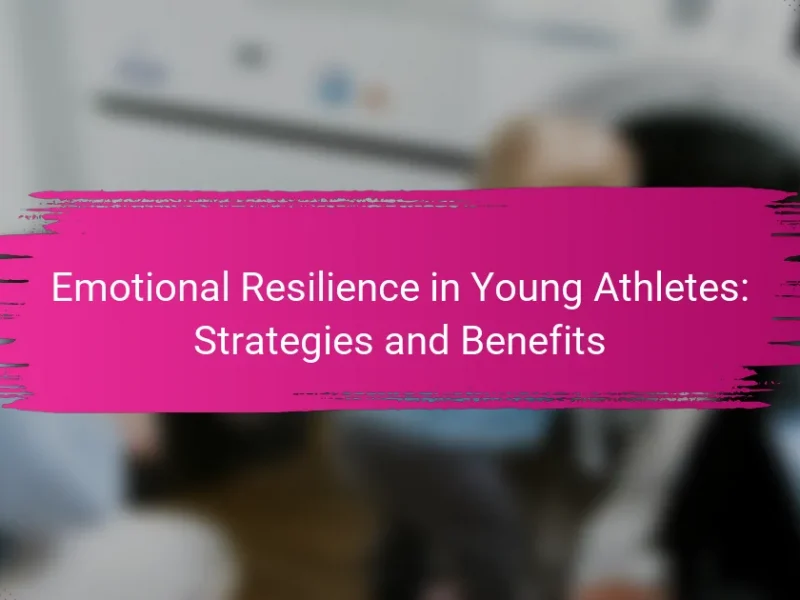Mindfulness techniques can significantly enhance stress management for young athletes in competitive sports. These methods include deep breathing, visualization, and body scanning. They improve focus, reduce anxiety, and promote emotional regulation. Incorporating these practices into training fosters mental resilience and overall well-being, equipping youth athletes to handle competitive pressures effectively.

What are the key mindfulness techniques for stress management in youth sports?
Mindfulness techniques for stress management in youth sports include deep breathing, visualization, and body scanning. These methods enhance focus and reduce anxiety during competition. Deep breathing helps regulate emotions by slowing heart rate. Visualization allows athletes to mentally rehearse successful performances, building confidence. Body scanning promotes awareness of physical sensations, aiding in relaxation. Implementing these techniques can significantly improve young athletes’ mental resilience and performance.
How does mindfulness impact youth athletes’ performance?
Mindfulness significantly enhances youth athletes’ performance by improving focus and reducing anxiety. Techniques such as breathing exercises and visualization help athletes manage stress effectively. Research indicates that regular mindfulness practice can lead to better decision-making and increased resilience during competitions. These benefits contribute to overall athletic development and enjoyment of the sport.
What are the common stressors faced by young athletes?
Young athletes commonly face stressors such as performance pressure, balancing academics and sports, and fear of injury. These factors can lead to anxiety and affect their overall well-being. Performance pressure often stems from expectations set by coaches, parents, or peers, which can be overwhelming. Balancing academics and sports commitments may result in time management challenges, leading to additional stress. Fear of injury can create anxiety about participation and performance. Mindfulness techniques can help mitigate these stressors, promoting mental resilience and focus.

What universal attributes define mindfulness techniques in youth sports?
Mindfulness techniques in youth sports are defined by their focus on enhancing mental resilience, emotional regulation, and concentration. These techniques foster self-awareness, promote relaxation, and reduce anxiety, crucial for young athletes. Key attributes include breath control, visualization, and body awareness. Each technique supports improved performance and overall well-being, making mindfulness an essential tool in youth sports.
How can breathing exercises help manage stress during competitions?
Breathing exercises significantly reduce stress during competitions by promoting relaxation and focus. These techniques help athletes manage anxiety, enhance concentration, and improve overall performance. Research indicates that controlled breathing lowers cortisol levels, a key stress hormone, enabling athletes to maintain composure under pressure. Regular practice of these exercises fosters a unique attribute of resilience, allowing young athletes to face competitive challenges with confidence.
What role does visualization play in reducing anxiety?
Visualization significantly reduces anxiety by enhancing focus and promoting relaxation. This technique allows young athletes to mentally rehearse their performance, leading to increased confidence and reduced stress levels. Studies indicate that visualization can activate the same brain regions as actual performance, creating a sense of familiarity and control. As a result, athletes can approach competitions with a calmer mindset, improving their overall mental well-being.
How does body awareness contribute to stress reduction?
Body awareness significantly contributes to stress reduction by enhancing mindfulness and promoting relaxation. Engaging in body awareness techniques, such as focused breathing and progressive muscle relaxation, allows young athletes to recognize physical tension and emotional stress. This recognition fosters a calm state, improving performance and overall well-being. Research indicates that athletes who practice body awareness report lower stress levels and better emotional regulation. By integrating these techniques into youth sports, coaches can help athletes manage stress effectively, leading to improved focus and resilience.

What unique mindfulness techniques are particularly effective for youth athletes?
Mindfulness techniques such as visualization, breathing exercises, and body scans are particularly effective for youth athletes. These practices enhance focus, reduce anxiety, and improve performance.
Visualization involves imagining successful outcomes, which helps athletes build confidence. Breathing exercises promote relaxation and can be done before competitions. Body scans encourage awareness of physical sensations, aiding in stress management during training.
Incorporating these techniques into regular practice can foster mental resilience and overall well-being in young athletes.
How can guided imagery be tailored for different sports?
Guided imagery can be tailored for different sports by focusing on sport-specific scenarios and desired outcomes. For example, in team sports, imagery can emphasize collaboration and communication, while individual sports may focus on personal performance and mental resilience.
Incorporating unique attributes like the specific skills required for each sport, such as visualization of a perfect swing in golf or a successful dive in swimming, enhances the effectiveness of the technique.
Additionally, adjusting the duration and frequency of imagery sessions can cater to the unique needs of athletes in various sports. For instance, shorter, more frequent sessions may benefit fast-paced sports, while longer sessions can be effective for sports requiring deep concentration.
Ultimately, customizing guided imagery to align with the athlete’s goals and the demands of their sport fosters better stress management and performance enhancement.
What specific mindfulness practices are popular among youth soccer players?
Youth soccer players commonly practice mindfulness techniques such as deep breathing, visualization, and body scanning. These methods help them manage stress and enhance focus during games and training.
Deep breathing exercises allow players to calm their minds and reduce anxiety before matches. Visualization techniques involve imagining successful performances, boosting confidence and mental preparedness. Body scanning helps players develop awareness of their physical state, promoting relaxation and reducing tension.
Incorporating these techniques into regular practice can lead to improved performance and overall well-being for young athletes.

What rare attributes of mindfulness techniques can enhance stress management?
Mindfulness techniques can enhance stress management in youth sports by fostering unique attributes such as emotional regulation, enhanced focus, and resilience. These rare traits allow young athletes to better handle pressure and setbacks. For instance, practices like mindful breathing and body scans can lead to immediate stress relief, while consistent mindfulness training may improve long-term coping strategies. Additionally, incorporating mindfulness into team dynamics can cultivate a supportive environment, further reducing stress levels among athletes.
How can nature-based mindfulness practices benefit young athletes?
Nature-based mindfulness practices can significantly enhance the mental resilience of young athletes. These techniques reduce stress, improve focus, and foster emotional regulation. Engaging with nature promotes a sense of calm, which is crucial during high-pressure situations in sports. Research indicates that exposure to natural environments can lower cortisol levels, leading to improved performance and well-being. Integrating practices like mindful walking or outdoor meditation can create a unique training advantage for youth athletes.
What innovative mindfulness apps are designed for youth sports?
Several innovative mindfulness apps cater specifically to youth sports, enhancing stress management and focus. Notable examples include Headspace for Kids, which offers tailored meditations, and Calm, featuring sports-specific mindfulness exercises. Insight Timer provides a vast library of guided sessions, while Smiling Mind focuses on mental well-being through age-appropriate programs. These apps utilize engaging techniques to help young athletes develop resilience and concentration, crucial for performance.

How can coaches incorporate mindfulness techniques into training sessions?
Coaches can incorporate mindfulness techniques into training sessions by integrating short meditation breaks, focusing on breath control, and encouraging present-moment awareness. These practices can enhance athletes’ stress management and improve performance.
Mindfulness can be introduced through guided imagery exercises, where athletes visualize successful performances. Regularly practicing these techniques fosters a calm mindset, helping youth athletes handle competitive pressures effectively.
Coaches can also implement mindfulness during warm-ups by encouraging athletes to concentrate on their movements and sensations. This approach cultivates greater self-awareness and emotional regulation, essential skills in youth sports.
Incorporating mindfulness into feedback sessions allows athletes to reflect on their experiences, promoting personal growth and resilience. This holistic approach supports both mental and physical development in young athletes.
What are the best practices for teaching mindfulness to young athletes?
To teach mindfulness effectively to young athletes, incorporate engaging and age-appropriate techniques. Use simple breathing exercises to promote relaxation and focus. Implement guided imagery to help athletes visualize success and manage stress. Encourage regular practice through short sessions, making it a fun routine. Foster a supportive environment where athletes can share experiences and feelings.
How can role-playing scenarios help in mindfulness training?
Role-playing scenarios enhance mindfulness training by immersing participants in real-life situations, fostering emotional awareness and stress management. These scenarios promote empathy, allowing youth athletes to better handle competition-related pressures. Engaging in role-play cultivates focus, as athletes practice mindfulness techniques in dynamic environments. This approach not only develops mental resilience but also encourages teamwork and communication skills, essential for success in sports.
What common mistakes should coaches avoid when implementing mindfulness?
Coaches should avoid common mistakes like inadequate training, neglecting individual needs, and inconsistent practice. These errors can hinder the effectiveness of mindfulness techniques in youth sports.
Firstly, failing to properly train in mindfulness can lead to ineffective implementation. Coaches must understand the principles and techniques to guide athletes effectively.
Secondly, overlooking the unique needs of each athlete can create resistance. Tailoring mindfulness practices to fit individual preferences enhances engagement and effectiveness.
Lastly, inconsistency in practice undermines the benefits of mindfulness. Regular, structured sessions are essential for athletes to experience lasting stress management benefits.

What are the long-term benefits of mindfulness for youth athletes?
Mindfulness offers long-term benefits for youth athletes, enhancing their mental resilience and performance. Regular practice improves focus, reduces anxiety, and fosters emotional regulation. Research shows that athletes who engage in mindfulness techniques experience decreased stress levels, leading to better performance under pressure. Additionally, mindfulness promotes a positive mindset, encouraging persistence and a growth-oriented approach to challenges. This holistic development not only benefits athletic performance but also supports overall well-being, making mindfulness a valuable tool in youth sports.
How can mindfulness techniques foster resilience in young athletes?
Mindfulness techniques enhance resilience in young athletes by promoting emotional regulation and focus. These practices help athletes manage stress, leading to improved performance and mental well-being. Techniques such as breathing exercises, visualization, and body scans foster self-awareness and reduce anxiety. Research shows that athletes who regularly practice mindfulness report lower stress levels and greater resilience during competition. Mindfulness training can be a unique attribute that distinguishes successful young athletes in high-pressure situations.
What strategies can parents use to support mindfulness practice at home?
Parents can support mindfulness practice at home by integrating simple techniques into daily routines. Encouraging deep breathing exercises before sports activities helps youth manage stress effectively. Setting aside time for guided meditation fosters relaxation and focus. Engaging in nature walks promotes awareness and connection to the environment. Using mindfulness apps can provide structured practice opportunities. Regularly discussing emotions enhances emotional intelligence and resilience. These strategies cultivate a supportive atmosphere for mindfulness in youth sports.
How can young athletes track their mindfulness progress effectively?
Young athletes can track their mindfulness progress effectively by using journals, apps, and regular self-assessments. Journaling allows athletes to reflect on their experiences and emotions during practices and competitions. Mindfulness apps provide guided exercises and progress tracking features. Regular self-assessments, such as rating their stress levels and mindfulness practices, help identify areas for improvement. Incorporating these methods fosters a consistent mindfulness practice and enhances overall performance in youth sports.

What actionable tips can enhance mindfulness practices in youth sports?
Incorporating mindfulness techniques can significantly enhance stress management in youth sports. Focus on these actionable tips:
1. Breathing exercises: Teach athletes to practice deep breathing to calm nerves before competitions.
2. Visualization: Encourage players to visualize successful performances, promoting confidence and focus.
3. Mindful movement: Integrate yoga or tai chi to enhance body awareness and reduce anxiety.
4. Positive affirmations: Foster a habit of using affirmations to build self-esteem and resilience.
5. Reflection sessions: Implement post-game discussions to reflect on experiences and emotions, promoting emotional intelligence.
How can setting realistic goals improve mindfulness outcomes?
Setting realistic goals enhances mindfulness outcomes by fostering achievable expectations. This approach reduces anxiety and promotes focus during youth sports. When athletes set specific, measurable objectives, they engage more deeply in the process, leading to improved stress management. Research shows that goal-setting correlates with enhanced performance and satisfaction in sports settings.
What are the essential elements of a successful mindfulness routine?
A successful mindfulness routine for youth sports includes focused breathing, body awareness, visualization, and regular practice. These elements help athletes manage stress and enhance performance. Focused breathing involves taking deep, intentional breaths to calm the mind. Body awareness encourages athletes to connect with their physical sensations, promoting relaxation. Visualization techniques allow athletes to imagine successful outcomes, boosting confidence. Regular practice ensures these techniques become ingrained, fostering resilience and mental clarity during competition.
How can peer support enhance mindfulness engagement among athletes?
Peer support significantly enhances mindfulness engagement among athletes by fostering a sense of belonging and accountability. This collaborative environment encourages open communication, allowing athletes to share experiences and techniques. As a result, they reinforce each other’s mindfulness practices, leading to improved focus and stress management. Studies indicate that athletes with strong peer support networks report higher levels of mindfulness, which correlates with better performance and mental resilience.


